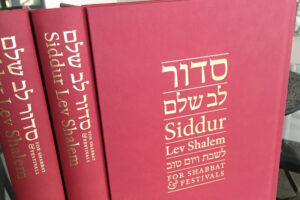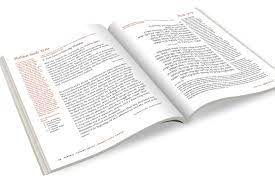 At Shabbat morning services on June 18, we are excited to announce that Shomrei will open a new ritual chapter. Thanks to the generosity of one of our member families, we will introduce the newest Siddur of the Conservative movement. Siddur Lev Shalem for Shabbat and Festivals joins Mahzor Lev Shalem as our primary source. Like the mahzor, it features a four-column format, new translations in contemporary language, a commentary providing historical context as well as kavanot (passages of intentionality), poetry and prose that expand and enrich our relationship to the text. For those who have used our Mahzor, you will find it very familiar.
At Shabbat morning services on June 18, we are excited to announce that Shomrei will open a new ritual chapter. Thanks to the generosity of one of our member families, we will introduce the newest Siddur of the Conservative movement. Siddur Lev Shalem for Shabbat and Festivals joins Mahzor Lev Shalem as our primary source. Like the mahzor, it features a four-column format, new translations in contemporary language, a commentary providing historical context as well as kavanot (passages of intentionality), poetry and prose that expand and enrich our relationship to the text. For those who have used our Mahzor, you will find it very familiar.
To help everyone navigate this wonderful new tool for prayer, Rabbi Greenstein will offer a short learning session immediately following Kiddush that day.
If you are interested in dedicating one of these beautiful new volumes, you may do so either online, or by contacting the office.
For those who continue to access our services digitally, an online link to Siddur Lev Shalem will replace the link we currently are using for Siddur Sim Shalom. We will be donating our copies of the Sim Shalom for Shabbat and Festivals to communities in need. If you would like to keep a copy or copies of the blue books for home use, please contact the office before June 18.
Here is an overview of the siddur from the Rabbinical Assembly:
A Prayerbook for Home and Synagogue
Siddur Lev Shalem is designed for use by individuals as well as for congregations, in the home and in the synagogue. The siddur begins with home preparation for Shabbat — including meditations on candle lighting, a song that incorporates halakhic instruction, a passage about the neshamah y’teirah (additional spirit) of Shabbat, an introduction to Shabbat from the Zohar, and much more.
 In the tradition of Mahzor Lev Shalem, the siddur includes an extraordinary array of sources and commentary — historical, halakhic, and spiritual. While the siddur includes all the traditional prayers, psalms, and songs that are familiar from previous Conservative siddurim, it serves also as an anthology, offering a wide array of readings that can be used to celebrate Shabbat as well as material for study about Shabbat: poems both ancient and modern, Hasidic wisdom, rabbinic midrashim, and commentary on the history and diversity of the liturgy. Today, as in the medieval synagogue, each community and individual can choose from the variety of texts offered, adding our own voices to the harmonious and lavishly textured “Song of Shabbat.”
In the tradition of Mahzor Lev Shalem, the siddur includes an extraordinary array of sources and commentary — historical, halakhic, and spiritual. While the siddur includes all the traditional prayers, psalms, and songs that are familiar from previous Conservative siddurim, it serves also as an anthology, offering a wide array of readings that can be used to celebrate Shabbat as well as material for study about Shabbat: poems both ancient and modern, Hasidic wisdom, rabbinic midrashim, and commentary on the history and diversity of the liturgy. Today, as in the medieval synagogue, each community and individual can choose from the variety of texts offered, adding our own voices to the harmonious and lavishly textured “Song of Shabbat.”
A Prayerbook for All Conservative Jews
Siddur Lev Shalem offers multiple pathways into the Jewish prayer experience and the celebration of Shabbat, reflecting the Conservative movement’s commitment to authenticity and its responsiveness to the evolving concerns and needs of all Conservative Jews. The siddur presents a highly readable translation in contemporary language; it respects English usage and may even be inspiring to the English reader. As with the mahzor, the English is a more literal translation of the Hebrew, with similar line breaks in English and Hebrew so that congregants can easily go back and forth between the two languages. In addition, all of the blessings, psalms, and songs are transliterated to enable Jews from all backgrounds to fully participate in the welcoming of Shabbat and the extensive commentary is geared to both the novice and the learned, offering both historical insight and spiritual meaning.
A Prayerbook for Anyone Attending a Synagogue Service
Part of what we intended by the title, Lev Shalem, is that all who come to synagogue should feel included in the recitation of Jewish liturgy and welcomed by the siddur. All of these features are responsive to the varying needs of the wide variety of congregants who inhabit our synagogue’s pews. Those attending a service for the first time — who may have wandered in perhaps in search of something they themselves cannot name or who are attending a bar or bat mitzvah or reciting kaddish — can now find their way into the siddur and Jewish liturgy. Those congregants who know some Hebrew can easily go back and forth between the English and the Hebrew. Hebrew davenners can better experience the flow of the service in a specially designed Hebrew type, whose clarity has been widely praised.
A Prayerbook that Reflects the Diversity of the Jewish Prayer Tradition
This siddur draws from the geographic and historical expanse of Jewish life. It includes all of the familiar psalms of Kabbalat Shabbat but also offers an earlier Friday night tradition from the Sephardic world where excerpts of Shir Ha-shirim (the Song of Songs) were sung as part of Kabbalat Shabbat. This allows for variety in davenning and also expands Jewish horizons when using the abundant commentary that surrounds the prayer text for study. As part of the “tool box” for using the siddur there will be various melodies for the songs of Kabbalat Shabbat available online as well as poems, prayers, and kavannot reflecting the 21st-century religious context.
The commentary also incorporates the range of Jewish wisdom about the liturgy from ancient to contemporary times: from the classical prophets to the rabbinic midrashim, along with the Rambam, Rav Nahman, Abraham Joshua Heschel, and the modern poets Zelda and Marge Piercy, to name just a very few whose words adorn the pages of Siddur Lev Shalem.
A Prayerbook with a More Prominent Role for Melodies, Niggunim and Chanting
The inclusion of Shir Ha-shirim and other poetry provides more opportunities to teach and sing exquisite melodies from the many Jewish musical traditions. Also, the unique “fourth column” of the siddur offers poems and readings that can be read, recited or sung responsively. The “tool box” will provide a variety of innovative possibilities for incorporating this material into the service.
A Prayerbook that Encourages More Personal Liturgical Responses
One of the stunning examples of a response to the needs of individuals is a Prayer in Place of Mourner’s Kaddish When a Minyan Is Not Present, deeply respectful of both the traditional insistence that a community be present for the mourner but also of the individual’s need to say Kaddish regardless of the number present. The siddur also includes a section of personal prayers before the open ark reflecting the fact that in many traditional communities the opening of the ark was seen as a moment that symbolized the opening of the gates of heaven and so became a time when some would approach the ark with personal gestures.
Geoff Sadow, Ritual Committee Chair
Miriam Korn Haims, President
- Announcing a New Siddur - Thu, May 12, 2022
- Jamming With Joey - Thu, Mar 7, 2019
